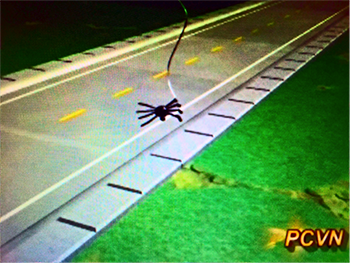|
Spider Specifics
By Dr. Stuart Mitchell
Do you surmise about spider specifics or can you specifically spell-out spider specifics? Now and then, studying spider specifics will allow you to answer studiously, specific questions about specified spider species.
Spider Biology Specifics1
Spiders are defined as any of the Order Araneae (arachnids) having an abdomen usually un-segmented and constricted at the base, chelicerae modified into poison fangs, and two or more pairs of abdominal spinnerets for spinning threads of silk for various uses (as in making cocoons for eggs or webs to capture prey).2
- Spiders have bodies divided into a cephalothorax and abdomen with eight joined legs.
- Palps function as sensory organs and serve males in reproduction.
- Upon molting, spiders exit the exoskeleton by pulling the legs out.
- Female spiders are usually larger than males.
- There are seven types of spider glands to produce various silks (protein masses), but each spider species possess only a selection of glands.
- By weight, spider dragline silk is 5x stronger than steel, 30% more flexible than nylon, 2x as elastic, and can absorb 3x the impact force of Kevlar.
- Spider webs do not desiccate or breakdown from micros.
- To allow moving from strand to strand and not sticking to webs, spiders have specific tarsal claws.
- Spiders balloon by using strands of silk as a wing to ride on air currents.
- Ground dwelling spiders line burrows with silk.
- All spiders are predators.
- Hunting spiders possess dense hair tufts called scapulae under tarsi (numerous surface contact points) that enable walking on smooth vertical surfaces and ceilings.
- Spiders eat a weight of insects greater than the weight of the human population.
- Most female spiders do not consume the male post-copulation.
- Spiders consume by injecting a digestive fluid then suck up the fluid.
- In the U.S., only about 60 species of spiders are capable of biting, and only four capable of injury (Black Widow, Brown Recluse, Hobo, and Yellow Sac spiders).
- Most spider fangs cannot penetrate human skin and are therefore harmless.
- Most spider bites result only in localized swelling and/or irritation.

Spider ballooning. (Source: Pest Control Video Network-PCVN).
Spider Control Specifics1
- Spider problem or lighting problem? Change blue light fixtures to yellow (Hg vapor or blue light is 112x more attractive to insects than Na vapor or yellow light-fewer insects, fewer spiders).
- Eliminate woodpiles, trash, rocks, and clutter or debris fields along exterior structural grade and foundation areas.
- Push out ballooning (air current dispersal of spiderlings on a line of silk) into a structure through positive pressure.
- Seal or caulk cracks, crevices, and gaps as well as check to be sure doors and windows are serviceable.
- Use pressure-washing systems as appropriate to eliminate heavy spider pressures.
- Mechanically broom down spider webs.
- Manage interior excess moisture and relative humidity through vent and dehumidifier systems.
- Vacuum (HEPA filter) webbing, egg sacks, spiders, and dead insects (place bag in sealed container for disposal).
- Use appropriate glue traps to capture and monitor spider species and pressure.
- Use professional products to strategically reduce and eliminate spider pressures (for web-constructing spiders, lightly dust the web as it maybe biologically recycled). There are a number of products available, including non-repellent options and products with minimal label restrictions.
- Natural products offer a great option for maintenance treatments, perimeter applications and spider infestations in locations near water.
- Always read, understand, and follow product label directions.
- Communication throughout the process of spider management is critical and will establish realistic expectations for your customers.
Sources:
1 Pest Control Video Network
2 Merriam-Webster.
|